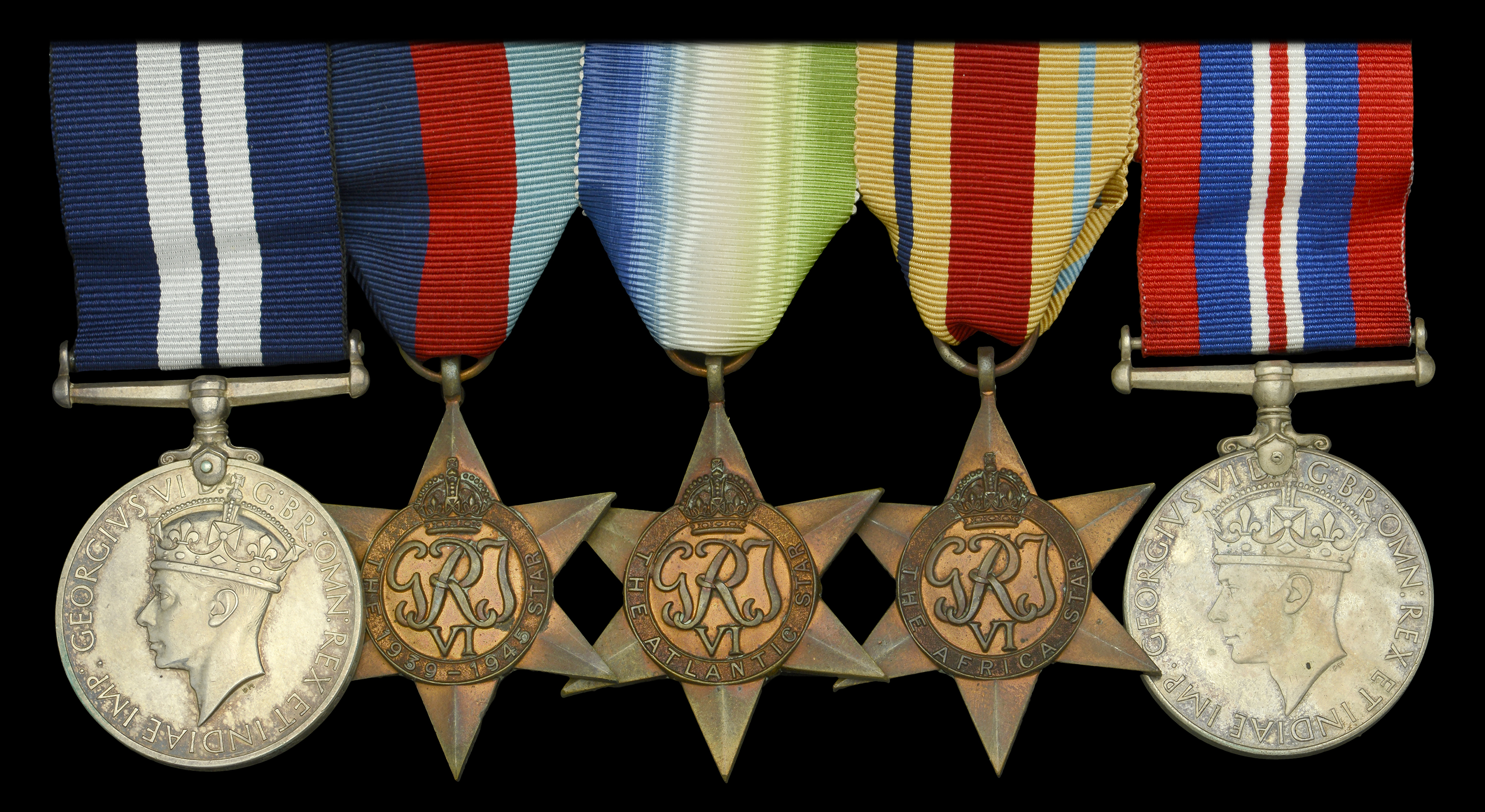The exceptional Second War D-Day Immediate D.S.M. group of five awarded to Stoker 1st Class W. G. Ingram, Royal Navy, who was decorated for his services in L.C.A. 722, which was damaged by enemy fire when landing U.S. Rangers on Pointe Du Hoc, four miles west of Omaha Beach, where the Rangers were tasked with destroying a German coastal battery of six 155mm. howitzers Distinguished Service Medal, G.VI.R. (Sto. 1 W. G. Ingram. P/KX.179183)officially engraved naming; 1939-45 Star; Atlantic Star; Africa Star; War Medal 1939-45, mounted as worn, good very fine (5) £2,400-£2,800 --- Importation Duty This lot is subject to importation duty of 5% on the hammer price unless exported outside the UK --- --- Provenance: Noble Auctions, Sydney, April 2005. D.S.M. London Gazette 28 November 1944: ‘For gallantry, skill, determination and undaunted devotion to duty during the landing of Allied Forces on the coast of Normandy.’ The original recommendation states: ‘He showed conspicuous skill and courage when his craft L.C.A. 722 was damaged by enemy action whilst under machine gunfire. Ingram made great efforts to repair his craft’s engines; although unsuccessful, his devotion to duty was a great example.’ Remarks of Intermediate Authority: ‘This rating had a very difficult task whilst landing U.S. Rangers on Pointe du Hoc.’ Walter Gordon Ingram, who was from Wandsworth, London, was embarked in H.M.S. Ben My Chree on the eve of Operation ‘Neptune’. An ex-Isle of Man ferry of 2,586 tons, which had been converted for use as a Landing Ship Infantry (Heavy), she was charged with transporting three companies of the 2nd U.S. Ranger Battalion to Normandy on D-Day. Thence disembarked to smaller assault landing craft, including L.C.A. 722 with Ingram, the Rangers arrived, under fire, at Pointe du Hoc in the Omaha Beach area, where they were assigned the unenvious mission of capturing the enemy positions on the high cliffs above. A glimpse of L.C.A. 722 and her occupants in action is to be found in the records of the 2nd Ranger Battalion’s assault on Pointe du Hoc: ‘Twenty yards left of Colonel Rudder’s craft, L.C.A. 722 hit shore with IS Company, E Rangers, five Headquarters’ men, a Stars and Stripes photographer, and a Commando officer who had assisted the Rangers in training. Touchdown was made at the edge of a crater, and the men could not avoid it in debarking. Enemy grenades were ineffectual, and the craters and debris on the beach gave sufficient cover from enfilading fire from the left. The only casualty was Pfc. John J. Sillman, wounded three times as the craft came in, hit twice on the beach, and destined to survive. A good deal of assorted equipment came on this craft, including the S.C.R. 284, two pigeons, a 60mm. mortar with ammunition, and some demolitions. All were got ashore without loss, though it took manoeuvring to avoid the deep water in the crater. Tech. 4 C. S. Parker and two other communications men hefted the big radio set on a pack board, and managed to get it in and working before the first climbers from 722 reached the top. The rockets had been fired just before landing. One ladder and one plain rope got up and held (L.C.A. 722 had experienced no trouble with water, and the ropes were comparatively dry). The single rope lay in a slight crevice, but the ladder came down on an overhang where it seemed exposed to the flanking fire and would be hard to climb. Tech. 5 Edward P. Smith tried the plain rope and found he could easily ‘walk it up.’ On top, three or four minutes after landing, he saw a group of Germans to his right throwing grenades over the cliff. Sgt. Hayward A. Robey joined Smith with a BAR. Robey lay in a shallow niche at the cliff edge and sprayed the grenadiers with 40 or 50 rounds fast fire. Three of the enemy dropped and the rest disappeared into shelters. Pfc. Frank H. Petersen, lightly wounded on the beach by a grenade, joined up and the three Rangers went off on their mission without waiting for the climbers. The mortar section in this boat team remained below, according to plan, with the purpose of setting up their 60mm. on the beach to deliver supporting fire. But the beach was too exposed to make this practicable, and time was consumed in getting ammunition from the one surviving supply craft. About 0745 the mortar team went on top without having yet fired … ’ Subsequently, in one of the most famous episodes of the landings, with covering fire from the destroyers H.M.S. Talybont and U.S.S. Satterlee, three companies of Rangers stormed the enemy’s battery positions and eliminated the remaining garrison. Thereafter, they maintained their position throughout the day. Sold with copied research.





